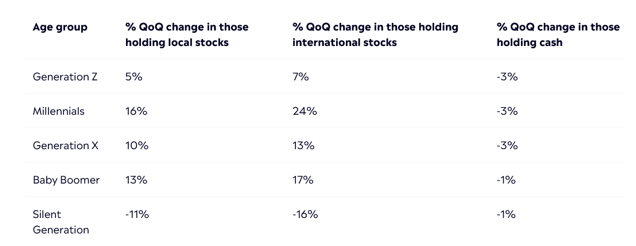While the Federal Reserve’s September interest rate cut is widely viewed as a catalyst for bonds, data confirm retail investors are upping their exposure to stocks.
Advisors may perceive that as too much of a good thing, but the charge into equities by retail market participants is being led in large part by millennials, many of whom have the luxury of time on their side. They can take risks and portfolios with hefty fixed income allocations may not be advisable for many investors in their 30s and 40s.
Financial professionals can also take heart in knowing that recent surveys indicate that the “silent generation,” or those folks born between 1928 and 1945, is reducing their equity allocations. That’s likely what an advisor would recommend for clients in their 70s and 80s.
Still, investors’ overall holdings of stocks is on the rise and that’s a trend for advisors to be aware, particularly among clients that hold a decent amount of assets outside the advisor’s purview.
Stocks Up, Cash Down
It could be a symptom of renewed animal spirits, fear of missing out, lower interest rates or all of those factors, but retail investors are indeed boosting equity holdings and they’re using capital from cash instruments to do that.
“In the study of 10,000 retail investors across 12 countries, those holding stocks listed in their local market grew by more than 10%, from 49% to 54%, while the increase in retail investors holding internationally-listed firms was even more significant, jumping 16%, from 31% to 36%. Meanwhile, those holding cash assets fell from 69% to 67%,” according to the latest edition of eToro’s Retail Investor Beat.
As noted in the chart below, cash holdings are down across the board, even among the silent generation, but exposure to equities is really increasing among younger retail investors.

Courtesy: eToro
Something that advisors might want to hone in on in the above chart is the extent to which baby boomers are pouring into stocks. Food for thought.
How Retail Is Responding to Lower Rates
As has been widely noted over the past several years, today’s retail investors are increasingly sophisticated. Access to data and technology has fostered that sophistication so it’s not surprising some are “Fed watchers” in their own right.
That’s born out in their responses to rate cuts and their desire to own stocks or funds they perceive as having positive leverage to monetary easing.
“The latest RIB data also showed that investors are looking for more sector diversification as interest rates begin to fall, with almost every single sector seeing an increase in terms of investor allocation. Whilst tech continued to be in focus, with a four percentage point increase in investors allocated to it (now 44%), healthcare (33%) and energy (38%) also saw significant three percentage point jumps,” concludes eToro.
Related: AI and Tech Are Shaping the Future for Financial Advisors


